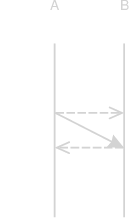README
Create sequence diagrams with a domain-specific language.
Usage: quence [-o type] [-v] [-h] FILE...
Options:
-n do not add project link to output
-o output type [pdf, svg, json] [string] [default: "pdf"]
-v verbose logging [boolean]
-h Show help [boolean]

Small example:
set text_color purple
Alice -> Bob: Hello #comment
Bob -> Alice: World
Bob -> Bob: !
Installation
Use npm:
npm install -g quence
Syntax
The following sections describe syntax that can be placed in a .wsd file for
input to the quence processor.
Comments
# [comment] Place a comment on a line by itself, or at the end of any line.
If you need a # in a string, enclose the string in double quotes (").
Participants
participant "[description]" as [name] Create a new participant in the order
that the participant directive appears in the input file. The description
is output, and the name is what is used for reference in later directives.

Example:
participant Alice
participant "Bob Cat" as bob
Arrows
Arrows are draw between participants with open ends, closed ends, solid or dashed lines, and may be bi-directional.
ends
< or > closed arrow end
<< or >> open arrow end
lines
- solid line
-- dashed line
Example:

# A "normal" message from A to B
A -> B
# An "exciting" message between A and B
# No, this doesn't have any defined meaning, as far as I know
A<-->>B
Messages
The minimum message looks like participant arrow participant, but a full description is:
[label:] participant[@time] arrow participant[@time] [:title] [[message options]]
Draw a line with
arrows between two participants. A participant
that has not been previously mentioned will be automatically created. Note
that a message may be of the form B -> B, which produces a self message.
Title

A message can have a title that will be drawn over the message line. The title will be justified toward the start of the message, or in the middle for bi-directional messages.
Example:
A->B: The title

Timestamps
Each message start time can have a timestamp associated with it by prefixing
the messagewith label:. Subsequent messages can be declared to start or end
at a given label by suffixing the participant name with @time, where time is
the label from a previous message.
This will usually result in a diagonal line.
Example:
early: A-->>B
late: B-->>A
A@early->B@late
Message options

Message options modify the message, and are of the form name [= value], with
multiple options separated by a comma (,). The following message options
may be set:
duration: The number of time slices that this message takes up. If this is not1, a diagonal line will result. [Default:1]advance: The number of time slices to advance the clock after this message. This is useful after a flurry of crossing diagonal lines. [Default:1]
Example:
A->B [duration=2, advance=2]
B->A [duration=2]
Options
set [option] [value] set an option governing the production of the diagram to
the given value. If the value is omitted, it defaults to true.
Defaults
The following options may be set (followed by their defaults):
arrow_color: blackarrow_height: 10arrow_width: 15auto_number: falsebackground: whiteblock_tab_fill: grayblock_stroke: graycolumn_width: 150font: Helveticaline_color: blackline_width: 1rung_color: blackrung_width: 1text_color: blacktext_size: 13time_height: 20
Programmatic Interface
var quence = require('quence');
quence.draw("A->B", "pdf", function(error, out) {
// err is `null` or an `Error`
// out is a `String` or `Buffer`
});
Supported Output Types
- SVG
- JSON
Quence was formerly known as "arrow", until I was asked very nicely to let another project use that name.